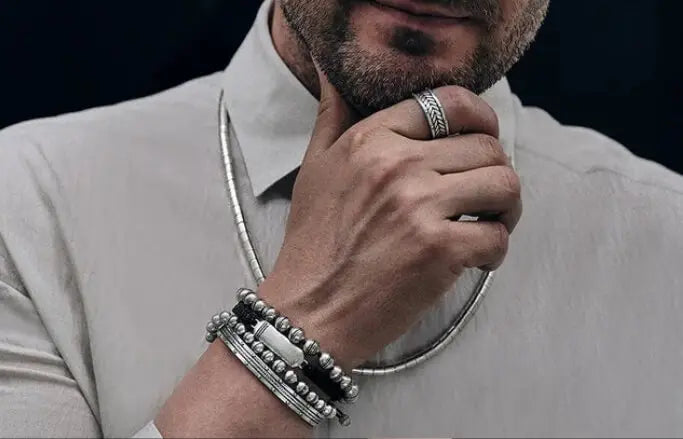Garnet is a stone historically associated with protection and conquest. What better stone to have around as we brace ourselves for the journey of the new year? You may want something to inspire you to conquer newfound resolutions—like being physically healthier, or spending more time with family. Whatever you’re looking forward to in the coming year, a beautiful, glistening red Garnet stone may be the perfect companion for your unique journey.

For those of us who call New York home, Garnet holds a very special place. It's the stone of conquest—in both love and battle. No wonder then, that it is New York’s official gemstone—the one place where the “making it” in all areas of life, be it business or love, is as about as good as anything can get.

GARNET BIRTHSTONE HISTORY
The history of garnet can be traced back to 3800 B.C. Ancient Egyptian Pharaohs adorned themselves with red garnet necklaces and kept the precious stones in their mummified tombs for safe keeping in the afterlife. If ancient pharaohs loved garnet so much, they wanted their spirits to have them too!
Ancient Egypt isn’t the only time in recorded history to prize the precious gem. The Old Testament regards it as one of the twelve stones on the breast plate of the high priest Aaron. And carbuncle—a reference to an ancient stone most often considered to be red garnet—was the only source of light on Noah’s Ark. The stone was so luminous that Noah trusted it to allow the remainder of all civilization to be able to see their way through the rainy days. Ancient wanderers wore the gem in order to light up the night during their journeys; Garnet is not only a gem of Biblical lore, but it is actually historically known to help people find their way in the dark!
The Romans carved garnet into signet rings that were used to stamp and seal official documents. They were widely favored by clergy and nobility in the middle ages. And civilizations across the ancient Americas and Africa also sanctified the stone.
Garnet, because of its red color, has an ancient association with war and battle. They are engraved in many ancient Viking swords, as they were believed to increase fighting prowess. Garnets were used as stones for sling bones in Asia; the red color was believed to heighten its ability to draw blood and inflict injury unto an opponent. Other cultures believed that if they wore the stone into battle, they would be protected from harm. Perhaps one should keep a garnet around if you feel the need for an extra little spiritual peace of mind when roaming about a wild and dangerous world.
The history of garnet can be traced back to 3800 B.C. Ancient Egyptian Pharaohs adorned themselves with red garnet necklaces and kept the precious stones in their mummified tombs for safe keeping in the afterlife. If ancient pharaohs loved garnet so much, they wanted their spirits to have them too!
Ancient Egypt isn’t the only time in recorded history to prize the precious gem. The Old Testament regards it as one of the twelve stones on the breast plate of the high priest Aaron. And carbuncle—a reference to an ancient stone most often considered to be red garnet—was the only source of light on Noah’s Ark. The stone was so luminous that Noah trusted it to allow the remainder of all civilization to be able to see their way through the rainy days. Ancient wanderers wore the gem in order to light up the night during their journeys; Garnet is not only a gem of Biblical lore, but it is actually historically known to help people find their way in the dark!
The Romans carved garnet into signet rings that were used to stamp and seal official documents. They were widely favored by clergy and nobility in the middle ages. And civilizations across the ancient Americas and Africa also sanctified the stone.
Garnet, because of its red color, has an ancient association with war and battle. They are engraved in many ancient Viking swords, as they were believed to increase fighting prowess. Garnets were used as stones for sling bones in Asia; the red color was believed to heighten its ability to draw blood and inflict injury unto an opponent. Other cultures believed that if they wore the stone into battle, they would be protected from harm. Perhaps one should keep a garnet around if you feel the need for an extra little spiritual peace of mind when roaming about a wild and dangerous world.
Garnet also has a very romantic story behind it — the ancient Greeks considered it to be a stone with the power to reunite and reconcile lost or feuding lovers. It can be hard to be apart from your special one for a long time—even if they’re just away for a business trip—keep a garnet around to help inspire the moments in which you may finally come together with the one you’re meant to be with.

GARNET BIRTHSTONE MEANING
The word Garnet has many roots, from Latin to Middle English, Italian and Russian—but they all lead back to the beautiful deep red of the Pomegranate seed. The Pomegranate is not only a delicious and juicy treat, it has been favored throughout history as a sacred fruit. The Greeks considered pomegranate to be a gift of passion and associated it with reunion and eternal love. Hades is said to have gifted Persephone a Pomegranate before her departure from the underworld in order to ensure her quick and safe return; when she finally did return, the seeds of the fruit transformed into Garnet stones.
The Victorian’s wore Garnet on engagement rings to represent fidelity of life; as a symbol for bonding, fidelity, and renewal, it is the perfect new year or second anniversary gift.
HOW TO CHOOSE THE JANUARY BIRTHSTONE
Garnet is found throughout the world—including Africa, India, Russia, South America, Madagascar, Pakistan, and the United States. It is a dense stone formed under pressure, usually in association with metamorphic rocks. Not all Garnets are red; they can be yellow, orange, green, pink, white, brown, and grey. Garnets are a 6.5 to 7.5 on the Mohs Scale of Hardness. Garnet is actually an entire family of gemstones that come in many different varieties. There are six species of Garnet; they are pyrope, almandine, spessartite, grossularite, uvarovite, and andradite. Among these species are over a dozen different varieties of Garnet.
Almandine: This is the most widely known variety of Garnet; it is usually red with a violet tint, hence its association with blood. Almandine is iron aluminum silicate.
Andradite: This species of Garnet contains three varieties.
Demantoid: A very valuable gemstone known for its exceptional luster and dispersion.
Melantine: This stone is black and opaque.
Topazolite: You can guess where this stone gets its name—its yellow to lemon yellow color makes it look similar to Topaz.
Color changing Garnet: A rare form of Garnet that can shift between brownish or orange when under the sun to a rosy color when under incandescent light.
Grossularite: This species is made of calcium aluminum silicate; it contains four varieties.
Hessonite: Known as “cinnamon stone” because it has reddish brown color.
Leuco: This stone is entirely colorless.
Hydrogrossular: This gem resembles Jade because of its green color and dense, opaque nature.
Tsavorite: Another very valuable variety of Garnet; this gemstone is bright green emerald green. Found in Africa.
Mali: A hybrid of grossular and andradite garnet; it has superb luster and dispersion and is green in color. Discovered in Mali in 1994.
Pyrope: Usually reddish brown. This is magnesium aluminum silicate.
Rhodolite: A hybrid of pyrope and almandite. Ranges from ruby to purple.
Spessartite: Mandarin to orange red.
Star Garnet: Only found in two places in the world—Idaho and India, this stone displays asterism, or a starry affect.
Uvarovite: Usually emerald-green. Calcium chromium silicate.

GARNET BIRTHSTONE CLEANING AND CARE
Garnet is a rather hard stone but should not be subject to hard blows or rough wear. Garnet does well under light and most chemicals but is not immune to hydrofluoric acid. All varieties of Garnet, except Demantoid, can be cleaned with an ultrasonic cleaner so long as they do not contain fractures. However, warm water with soap is usually enough. Never use steam to clean a Garnet stone. If the stone has fractures, then only use warm water with soap.
Today, Garnet is still considered a protective stone—guarding its wearers from negativity and bad dreams. It is a stone of higher thinking and self-empowerment that brings strength and safety, as well as prosperity and abundance, while encouraging gratitude and service to others. Garnet is associated with the sacral base, solar plexus, and heart chakras; it brings peace, balance, and guidance. If you’re looking to start a home business, keep a Garnet stone to guide people and prospects to you. The stone can also re-energize a romantic relationship by boosting loyalty, love, honesty, and compassion. Legend says that exchanging a gift of garnet when parting from a friend will ensure that you meet again. How perfect a gemstone to grant to those whom you will all too soon be departing from after a wonderful holiday season.
Shop Garnet Birthstone jewelry HERE.




